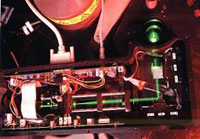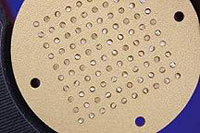Development of Single Grain Methods
 At the turn of the Millennium a collaboration with Risø National Laboratory (now Department of Physics, DTU, Denmark) led to the development of the first practical single grain optically stimulated luminescence (OSL) system. As can be seen in the image on the left, this system consists of a green (532 nm) laser which can be steered to any position within the measurement chamber. The beam can then be directed to stimulate the luminescence from any one of a hundred grains mounted on a special 9.7 mm diameter aluminium holder (see below). The measurement chamber, where the sample is placed, is in the upper-right of the picture. In normal operation the entire system is covered in order to make it light-tight. Typically grains between 180 and 210 micrometers in diameter are used. In later work in 2003 the instrument was developed to add a second laser (830 nm) to stimulate feldspars.
At the turn of the Millennium a collaboration with Risø National Laboratory (now Department of Physics, DTU, Denmark) led to the development of the first practical single grain optically stimulated luminescence (OSL) system. As can be seen in the image on the left, this system consists of a green (532 nm) laser which can be steered to any position within the measurement chamber. The beam can then be directed to stimulate the luminescence from any one of a hundred grains mounted on a special 9.7 mm diameter aluminium holder (see below). The measurement chamber, where the sample is placed, is in the upper-right of the picture. In normal operation the entire system is covered in order to make it light-tight. Typically grains between 180 and 210 micrometers in diameter are used. In later work in 2003 the instrument was developed to add a second laser (830 nm) to stimulate feldspars.
The ability to measure individual grains is vital when dealing with complex sediments where it is not possible to assume that all grains were exposed to sufficient daylight at the time of deposition for the luminescence signal to be completely reset. Such complex mixtures of grains, some of which have had their luminescence signal reset and other which have not, may exist in a range of depositional settings. We have undertaken research into glacial and fluvially deposited sediments. In addition, in archaeological sites, especially cave sites, there may be a possibility that sediment mixtures occur.
The instrument is now used widely in laboratories across the world, and results obtained from this instrument have been essential in a number of areas.
- Archaeological sites - the potential for complex depositional processes at archaeological sites has meant that measurements of single grains have been used extensively to ensure that issues of contamination and incomplete bleaching can be identified and overcome. the technique has seen particular application to Middle Stone Age (MSA) sites in Africa, Arabia, SE Asia and Australasia
- Glacial sediments - ensuring that sediments have been exposed to sufficient daylight at deposition for resetting of the luminescence signal being used to date is difficult for glacial sediments. Single grain methods have been used extensively to solve this problem, and found particular application in the BRITICE-CHRONO project in the UK
- Soil processes - rates of turnover of sedimentary material by biological processes in soils is important in understanding how soils form, but is challenging to measure. Measurements of the luminescence from single grains has been used to calculate the rate of turnover
Recent research is attempting to understand the extent to which variability observed in luminescence signals results from variations in resetting at the time of deposition, or from variations in dose rate to individual grains. Further understanding of the causes of variability, and methods designed to reduce variability due to instrumental factors, is an area of ongoing research effort.

Above: A sample holder for single grain measurements. The aluminium disc is 9.7 mm in diameter. A grain of quartz is in each of the 100 holes.
Further reading:
Bøtter-Jensen, L., Andersen, C.E., Duller, G.A.T., Murray, A.S. (2003) Developments in radiation, stimulation and observation facilities in luminescence measurements. Radiation Measurements 37, 535-541.
Duller, G.A.T., Murray, A.S. (2000) Luminescence dating of sediments using individual mineral grains. Geologos 5, 88-106.
Duller, G.A.T. (2003) Distinguishing quartz and feldspar in single grain luminescence measurements. Radiation Measurements 37, 161-165.
Duller, G.A.T., Bøtter-Jensen, L., Murray, A.S. (2003) Combining infrared-and green-laser stimulation sources in single-grain luminescence measurements of feldspar and quartz. Radiation Measurements 37, 543-550.
Duller, G.A.T. (2004) Luminescence dating of Quaternary sediments: recent developments. Journal of Quaternary Science19, 183-192.
Duller, G.A.T. (2008) Single grain optical dating of Quaternary sediments: why aliquot size matters in luminescence dating. Boreas 37, 589-612
Duller, G.A.T. (2012). Cross-talk during single grain optically stimulated luminescence measurements of quartz and feldspar. Radiation Measurements 47: 219-224.
Duller, G.A.T. (2012). Improving the accuracy and precision of equivalent doses determined using the optically stimulated luminescence signal from single grains of quartz. Radiation Measurements 47: 770-777.
Smedley, R.K., Scourse, J.D., Small, D., Hiemstra, J.F., Duller, G.A.T., Bateman, M.D., Burke, M.J., Chiverrell, R.C., Clark, C.D., Davies, S.M., Fabel, D., Gheorghiu, D.M., McCarroll, D., Medialdea, A. and Xu, S. (2017). New age constraints for the limit of the British–Irish Ice Sheet on the Isles of Scilly. Journal of Quaternary Science 32(1): 48-62.
Smedley, R.K., Duller, G.A.T., Rufer, D. and Utley, J.E.P. (2020). Empirical assessment of beta dose heterogeneity in sediments: Implications for luminescence dating. Quaternary Geochronology 56: 101052.
